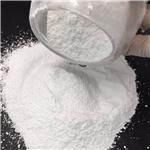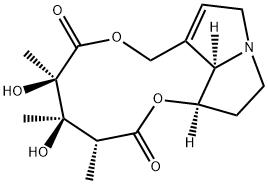- Monocrotaline
-

- $0.00 / 20mg
-
2023-02-24
- CAS:315-22-0
- Min. Order: 5mg
- Purity: ≥98%(HPLC)
- Supply Ability: 10 g
- Monocrotaline
-

- $90.00 / 1kg
-
2023-02-13
- CAS:315-22-0
- Min. Order: 1kg
- Purity: 99%
- Supply Ability: 100MT
- MONOCROTALINE USP/EP/BP
-

- $1.10 / 1g
-
2021-07-03
- CAS:315-22-0
- Min. Order: 1g
- Purity: 99.9%
- Supply Ability: 100 Tons Min
|
| Product Name: | MONOCROTALINE | | Synonyms: | (13-alpha,14-alpha)-14,19-dihydro-12,13-dihydroxy-20-norcrotalanan-11,15-dio;(13-alpha,14-alpha)-14,19-Dihydro-12,13-dihydroxy-20-norcrotalanan-11,15-dione;(2,3,4-gh)pyrrolizine-2,6(3h)-dione,(4,5,8,10,12,13,13a,13b-octahydro-4,5-dihy;(2,3,4-gh)pyrrolizine-2,6(3H)-dione,(4,5,8,10,12,13,13a,13b-octahydro-4,5-dihydroxy-3,4,5-trimethyl-2H-(1,6)dioxacycloundecino-;12-beta,13-beta-dihydroxy-12-alpha,13-alpha,14-alpha-trimethylcrotal-1-enine;12beta,13beta-Dihydroxy-12alpha,13alpha,14alpha-trimethylcrotal-1-enine;14,19-dihydro-12,13-dihydroxy(13-alpha,14-alpha)-20-norcrotalanan-11,15-dione;14,19-Dihydro-12,13-dihydroxy(13alpha,14alpha)-20-norcrotalanan-11,15-dione | | CAS: | 315-22-0 | | MF: | C16H23NO6 | | MW: | 325.36 | | EINECS: | 628-506-2 | | Product Categories: | Inhibitors;Amines;Heterocycles;chemical reagent;pharmaceutical intermediate;phytochemical;reference standards from Chinese medicinal herbs (TCM).;standardized herbal extract;Miscellaneous Natural Products | | Mol File: | 315-22-0.mol |  |
| | MONOCROTALINE Chemical Properties |
| Melting point | 204 °C (dec.) (lit.) | | alpha | -54.8o (C=5 IN CHLOROFORM) | | Boiling point | 463.55°C (rough estimate) | | density | 1.1512 (rough estimate) | | refractive index | 1.5500 (estimate) | | storage temp. | 2-8°C | | solubility | Soluble in DMSO (up to 50 mg/ml with warming), in Ethanol (up to 10 mg/ml with warming) or in organic solvents such as Chloroform (up to 50 mg/ml) | | pka | 12.21±0.60(Predicted) | | color | White | | Water Solubility | 11.86g/L(temperature not stated) | | Merck | 13,6274 | | BRN | 48732 | | Stability: | Stable for 1 year from date of purchase as supplied. Solutions in DMSO or ethanol may be stored at -20°C for up to 1 month. | | InChIKey | QVCMHGGNRFRMAD-XFGHUUIASA-N | | LogP | -0.370 (est) | | IARC | 2B (Vol. 10, Sup 7) 1987 | | EPA Substance Registry System | Monocrotaline (315-22-0) |
| Hazard Codes | T | | Risk Statements | 25-40-35 | | Safety Statements | 36/37/39-45 | | RIDADR | UN 1544 6.1/PG 3 | | WGK Germany | 3 | | RTECS | QB3140000 | | HazardClass | 6.1(b) | | PackingGroup | III | | HS Code | 29399990 | | Hazardous Substances Data | 315-22-0(Hazardous Substances Data) | | Toxicity | LD50 orally in rats: 71 mg/kg (Newberne) |
| | MONOCROTALINE Usage And Synthesis |
| Description | Monocrotaline (MCT) is a toxic 11-membered macrocyclic pyrrolizidine alkaloid (PA) derived from the seeds of the Crotalaria spectabilis plant. It poisons livestock and humans through the ingestion of contaminated grains and other foods. Pyrrolizidine alkaloid is activated by cytochrome P450 to the reactive pyrrole metabolite dehydromonocrotaline (MCTP) in the liver. The alkaloid causes pulmonary artery hypertension, right ventricular hypertrophy, and pathological changes in the pulmonary vasculature.
Monocrotaline is produced for research use. It is used in rat model to investigate human pulmonary hypertension as it offers technical simplicity, reproducibility, and low cost compared with other models of pulmonary hypertension.
| | References | [1] Jose G. Gomez-Arroyo, Laszlo Farkas, Aysar A. Alhussaini, Daniela Farkas, Donatas Kraskauskas, Norbert F. Voelkel, Harm J. Bogaard (2012) The monocrotaline model of pulmonary hypertension in perspective, Am J Physio Lung Cell Mol Phyisol, 302, L363-L369
[2] https://pubchem.ncbi.nlm.nih.gov/compound/monocrotaline#section=Top
| | Description | A hepatotoxic alkaloid of the pyrrolizidine group obtained from Crotalaria
retusa and C. spectabilis, the base is laevorotatory with [α]26D - 55.7° (CHCI3).
It may be characterized as the hydrochloride, m.p. 184°C ldec.); [α]28D - 38.4°
(H20) and the methiodide which crystallizes from MeOH with 3 moles of
solvent, m.p. 205°C (dry, dec.); [α]28D + 23.4° (MeOH). Hydrolysis with boiling
Ba(OHh furnishes retronecine and monocrotic acid, C7H120 3, b.p. 145-6°C/
18 mm which is optically inactive. This acid yields a methyl ester, b.p. 94-6°Cj
18 mm, a p-bromophenacyl ester, m.p. 78°C and a 2:4-dinitrophenylhydrazone,
m.p. 95-6°C. Hydrogenation in the presence of Pt02 as catalyst yields retro_x0002_necanol and monocrotalic acid, CSH120S' m.p. 181-2°C; [α]28D - 5.33° (H20)
which gives a methyl ester, m.p. 79-800 C; [α]30D - 16.2° (EtOH) and a p�bromophenacyl ester, m.p. 162-3°C. | | Chemical Properties | White to light tan powder | | Physical properties | Appearance: white prism crystal. Solubility: soluble in methanol, ethanol, and chloroform; slightly soluble in benzene, water, ether, and acetone; insoluble in petroleum ether. Melting point: 197–198 °C. Specific optical rotation: ?54.7 ° (in
chloroform). | | History | In 1935, W.?M. Neil and L.?L. Russoff isolated monocrotaline from Crotalaria sessiliflora L.?Monocrotaline showed anticancer activity in?vivo, especially for treating squamous cell carcinoma, cervical cancer, and leukemia. However, since many pyrrolizidine alkaloid compounds have hepatotoxicity, further development of these compounds is restricted.
China began the research of monocrotaline, as early as 1943. Crotalaria sessiliflora L. was also recorded in the 1977 edition of the Pharmacopoeia of the People’s Republic of China. But monocrotaline was reported for its liver toxicity; teratogenic,
allergic reactions; and other side effects, limiting its further clinical applications. In
1992, the Ministry of Health stopped the clinical application of monocrotaline injection. Further pharmacology study is essential for monocrotaline . | | Uses | antineoplastic, insect sterilant | | Uses | Crotaline has been used in hydrochloric acid (HCl) and injected into experimental animals to induce-pulmonary hypertension. | | Uses | A toxic pyrrolizidine alkaloid isolated from Crotalaria spp. It is used for inducing pulmonary diseases in rats. | | Definition | ChEBI: Monocrotaline is a pyrrolizidine alkaloid. | | Indications | This product is available in the Pharmacopoeia of the People’s Republic of China (1977).
Clinical available formulations include gel and liposome transdermal preparations. It is effective in treating skin cancer, basal cell carcinoma, acute leukemia,
and cervical and penile cancer. | | General Description | This substance is a primary reference substance with assigned absolute purity (considering chromatographic purity, water, residual solvents, inorganic impurities). The exact value can be found on the certificate. Produced by PhytoLab GmbH & Co. KG | | Biochem/physiol Actions | Crotaline induces pulmonary vascular syndrome in rats. It is considered toxic and results in hepatic cirrhosis, enlarged liver, sinusoidal obstruction syndrome and right ventricular hypertrophy. | | Pharmacology | Monocrotaline is a pyrrolizidine alkaloid which has anticancer and anti-choline effects. In vitro study suggested that monocrotaline has significant cytotoxicity in human BEL-7402, KB cancer cells through inducing DNA alkylation . Monocrotaline’s toxicity is low, but its metabolites in the liver have high liver toxicity. The metabolites are highly electrophilic and can bind to enzymes, proteins, DNA, and RNA, thus causing several side effects. Monocrotaline can reduce blood pressure and inhibit cardiac contractility and heart rate and also shows mild inhibition of respiratory rate and depth. | | Clinical Use | Monocrotaline injection shows well therapeutic effect for treating squamous cell carcinoma and basal cell carcinoma. In folk, the fresh pulp or dry powder of the herb has been also used for treating squamous cell carcinoma and basal cell carcinoma . | | Safety Profile | Suspected carcinogen
with experimental carcinogenic data. Poison
by ingestion, intravenous, intraperitoneal,
and subcutaneous routes. Human mutation
data reported. When heated to
decomposition it emits toxic fumes of NOx. | | Purification Methods | Crotaline forms prisms from absolute EtOH and recrystallises also from CHCl3. UV in 96% EtOH has max 217nm (log � 3.32). [Adams et al. J Am Chem Soc 74 5612 1952, Culvenor & Smith Aust J Chem 10 474 1957.] The hydrochloride has m 212-214o (from MeOH/Et2O) and [] D28 -38.4o (c 5, H2O) [Adams & Gianturco J Am Chem Soc 78 1922 1956]. The picrate has m 230-231.5o(dec) [Adams et al. J Am Chem Soc 74 5614 1952]. [Beilstein 27 III/IV 6660.] | | References | Adams, Rogers., J. Amer. Chern. Soc., 61,2815 (1939) |
| | MONOCROTALINE Preparation Products And Raw materials |
| Raw materials | 1,3-Dioxolane-4-acetic acid, α,4,5-trimethyl-5-[[2-(trimethylsilyl)ethoxy]carbonyl]-, 2,3,5,7a-tetrahydro-7-(hydroxymethyl)-1H-pyrrolizin-1-yl ester, [1α[R*(4R*,5R*)],7aβ]- (9CI) |
|